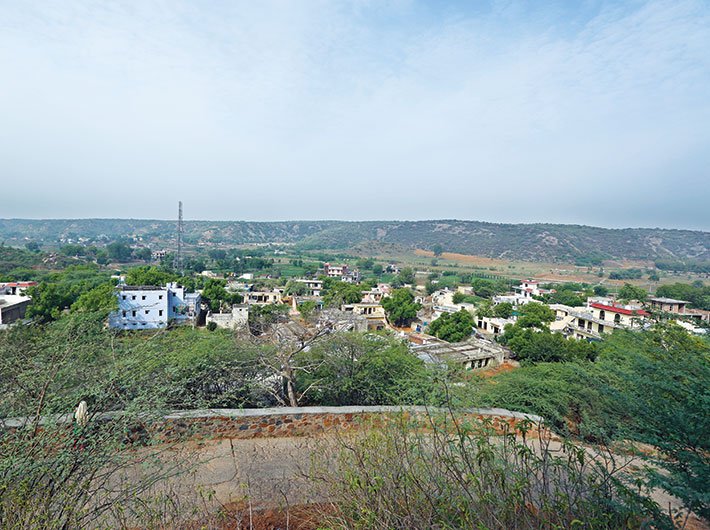In Faridabad, 750 acres of a sacred grove is slipping into commercial use. Villagers and environmentalists try to stop the realtors chafing to claim their bounty
It’s not usual for the prime minister’s office (PMO) to get involved in a state government’s development plan for a small area. Yet the status of a patch of forest in Haryana’s Faridabad district has created an unusual administrative schism.
The PMO and the central environment ministry stand alongside environmentalists and some villagers who want to conserve that forest. Turning a blind eye towards these concerns is the state government, supported by the central urban development ministry. It seeks commercial development on the forested land.
At stake is 3,500 acres of forests on the common lands of Mangar, a Faridabad village. At first sight, the forest looks like any patch of green on the foothills of the Aravali mountain range. The difference lies in the way the village relates to the forest. For the forest includes a patch of 750 acres of sacred forest that the village has left untouched. Several villagers claim their efforts are to uphold the sanctity of a forest that combines natural conservation with faith.
The environmentalists have a different, though syncretic, reason. It is among the last patches of preserved natural vegetation in the national capital region (NCR); the forest is important to recharging groundwater in Faridabad and adjoining Gurgaon, where groundwater withdrawal is alarming. Besides, as Faridabad forest officials point out, the patch and its surrounding forest is home to protected wild animals like leopards and nilgai.
The Haryana government, though, has commerce in sight. In May, it notified its sub-regional plan for 2021; it lays down policy for district-wise land use. Under this, the administration sought to allow eco-tourism in this forest. It also proposed to curtail the boundary of the natural conservation zone (NCZ) here. Villagers and environmentalists fear this will open the floodgates for real estate businesses.
Regional planning: a farce
They iterate that Faridabad is a part of the NCR; all decisions on land use here must conform with NCR plans. Regulation and approval of such plans lies in the remit of an NCR board under the ministry of urban development (MoUD).
Which is why when the PMO wanted to stress the importance of conserving this forest, it wrote a letter on March 5 to the ministry. It urged that MoUD not go ahead with any finality on planning in the Aravalis without taking into account the views of the ministry of environment and forests (MoEF).
The letter referred to concerns on provisions that will allow tourism in the Aravalis and relax the natural conservation zone and the cap on construction it exerts. Investigation shows PMO decided on the letter to support the environment ministry, which had already sent two letters underlining environmental concerns.
MoUD put paid to their concerns. It hurried a special meeting of the NCR board on April 25 – a time when all government machinery was gearing for the general elections. In fact, three of the four NCR states – Delhi, Rajasthan and UP – were unable to attend the meeting due to the administrative focus on the elections. Haryana, meanwhile, managed to send its two top bureaucrats and other representatives to that meeting.
“The MoUD apparently acted under pressure from realtors who own large tracts of land in Mangar. They are waiting to get change of land use (CLU) permissions for construction of residential and commercial projects,” says Colonel (retired) Sarvadaman Oberoi, who settled in Gurgaon after retiring from the army a decade ago. Oberoi turned an activist after getting first-hand experience of dealing with the administration-builder nexus in Gurgaon, which has spawned unregulated urbanisation at the cost of environmental depletion.
He has submitted a complaint regarding the Mangar forest and is following up with the new urban development minister M Venkaiah Naidu.
Bending rules like Haryana
That eco-tourism is a front for recreational resorts and hotels is a widespread fear. This resulted in pressure on the state government, which then dropped the provision for eco-tourism from its plans. Then, it tweaked many an existing rules. The new sub-regional plan reclassifies parts of the Aravalis falling in urbanisable areas. This means such areas are outside the natural conservation zone.
“Will they hand over any part of Aravalis to realtors by passing it off as an urbanisable area?” asks Chetan Agarwal, an environmentalist who has closely studied the ecological benefits of the Mangar forest. Along with villagers, he has made several representations to the MoUD and MoEF to raise concern over the Haryana government’s designs.
Mangar village is six kilometres off the Gurgaon-Faridabad expressway. The single-lane concrete road between the village and the expressway is already dotted with farmhouses of industrialists, politicians, cricketers and journalists. Along the four-lane expressway is mushrooming a crop of real estate constructions, mainly residential high-rises and IT parks.
In the middle of all this – and in the middle of the 3,500 acres of forests – is the sacred patch of about 750 acres. Villagers call it Mangar Bani and treat it like a sacred grove. They believe their guardian spirit resides in that forest. Inside the Bani (it means forest in Hindi) lies the shrine of Gudaria Baba, a highly regarded saint. “We don’t pluck even a leaf out of the forest,” says 26-year-old Sunil Harsana, a member of the Mangar Village Vikas Samiti, a group fighting the Bani’s commercialisation.
A protected buffer zone with a radius of 500 metres radius lay around the Bani, precluding construction. On May 25 this year, the new regional plan came into force. It has reduced the protected area by 90 percent – the radius reduced to 60 metres. The state government’s proposed land use plan doesn’t even earmark the periphery of the Mangar Bani and its buffer, thereby leaving plenty of room for confusion and land grab. This, say villagers, is deliberate.
How realtors got a toehold
Mangar is a small village with 2,000-odd residents. About 85 percent belong to the Gujjar community, while remaining from the scheduled castes, besides a dozen Brahmin families.
Bani forest is earmarked in the revenue records as ‘gair mumkin pahad’, which means land unfit for human habitation or agriculture. The village panchayat holds it as village commons.
In the 1970s, when the privatisation of village commons began in right earnest across the country, Mangar residents got shares in the forest (including the Bani) in proportion to their land holdings. However, the revenue department did not demarcate this allocation, so the villagers had no idea the parcel of land that belonged to them.
In the 1980s, some villagers began selling their share of undemarcated land to speculative investors – about 250 acres was transacted in this way. “It was only in 1986 that chakbandi (land demarcation) began. We suddenly realised we had sold off a major part of our sacred Bani, too,” says Meher Singh, an elderly resident. “Some villagers played middlemen for businessmen. They fooled us into believing that the land was not part of the sacred Bani, only wasteland not fit for agriculture,” he says.
Realtors in the area have a different account. They say that some villagers favour selling off their shares in Bani even today. “Through the 1980s, when the villagers sold a major chunk of ‘gair mumkin pahad’, most of them did it wilfully. Now that the Bani has caught the attention of the environmentalists and the media, they claim to be protecting it,” said a local property dealer who didn’t wish to be named.
With the land pockets in Gurgaon, Faridabad and adjoining parts of south Delhi largely built over, realtors now eye this area, which has already seen a considerable surge in construction in the past five years or so.
The town and country planning (TCP) department of the Haryana government in 2011 brought the Mangar draft development plan (DDP), 2031 in which it proposed the construction of commercial and residential properties, hotels, airports, railway stations and other ‘developmental’ activities.
Since then, land prices have shot up and realtors who own pockets of land in the region have lobbied to get possession of their share. An acre (0.4 hectare) of land in and around Mangar is now going for Rs 50 lakh.
In 2009, an empowered committee that advises the supreme court on forest matters had proposed that the ownership of the Mangar Bani be handed over to the state’s forest department to secure it from land sharks. The suggestion fell on deaf ears.
(The story appeared in the July 16-31, 2014 issue of the magazine.)

